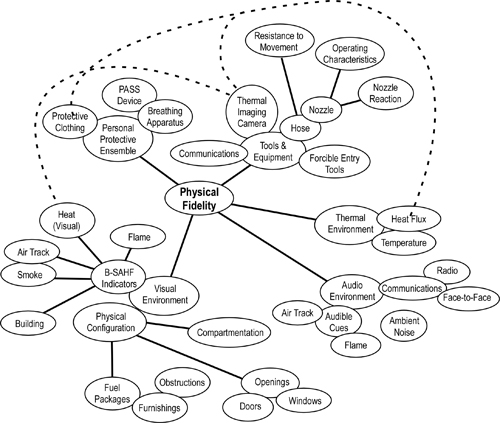Several earlier posts (Training Fires Versus Real Fires, Live Fire Training: Important Questions) introduced the concepts of live fire training as simulation, physical fidelity, and functional fidelity. This post will dig a bit deeper into what aspects of fidelity may be important in live fire training.
Interesting Puzzle
Physical fidelity is the extent to which the simulation looks and feels real. Functional fidelity is the extent to which the simulation works and reacts realistically. In Live Fire Training: Important Questions, I presented a puzzle provided by Roy Reyes of the Swedish Civil Contingencies Agency. He forwarded me the following photo (Figure 1) from a fire behavior instructor course that he had conducted in Valencia, Spain and posed two questions, one quite general and the other very specific:
- What do you see in the photo?
- Why are the flames in the hot gas layer in the center, and not across the entire width of the compartment?
Figure 1. Participants Conducting Fire Behavior Demonstration 2

Physical and functional fidelity are potentially quite important in developing firefighters understanding of fire behavior and skill in application of fire control techniques. The two questions that Roy asks are important (and I will get back to them). However, two more fundamental questions could be asked: 1) To what extent is the fire behavior in this container based prop reflective of conditions that would be encountered in a “real” fire? 2) Does it matter (given the learning outcomes intended for this training session)?
Physical Fidelity
Physical fidelity is important in providing visual, audible, and tactile cues that are essential to developing and maintaining situational awareness. In addition, physical fidelity is a key component in firefighters’ perception of the realism of the simulation.
The concept of physical fidelity is simple. However, when you start to think about the live fire training environment, it quickly becomes more complex. The elements of fidelity related to flight simulation discussed in Live Fire Training: Important Questions as a starting point. Physical fidelity may include the firefighters’ personal protective ensemble, tools, and equipment as well as visual, audio, and thermal aspects of the environment. As illustrated in Figure 2, a number of these elements of physical fidelity are interrelated.
Figure 2. Physical Fidelity Concept Map

This concept map is a simple and preliminary look at the elements of physical fidelity. Each of the concepts illustrated can be further refined and elaborated on to provide a clearer picture of physical fidelity in live fire training.
Functional Fidelity
While physical fidelity is important, functional fidelity; realistic functioning of the simulation, is likely even more important. Development of critical skills and the ability to read the impact of tactical action is dependent on adequate functional fidelity.
As with physical fidelity, the concept is straight forward, the simulation should function in a realistic manner. However, this is likely to be even more complex than simply looking realistic.
Roy’s puzzle provides an interesting starting point to think about the nature, function, and importance of functional fidelity.
The first question asked, what do you see in the photo? Firefighters are engaged in a training session in a container based CFBT cell with a fire located in the front on the right side. A well defined hot gas layer has developed with flames extending through the hot gas layer at the center of the compartment.
The second question is more significant. Why are the flames extending in the hot gas layer in the center of the compartment and not across the full width of the compartment? There could be a number of possible explanations, but it is likely that the metal walls of the container are acting as thermal ballast. Energy used to increase the temperature of the metal compartment walls (which have excellent thermal conductivity) is not being used in the combustion process (preventing flaming combustion next to the walls). The same phenomenon can be demonstrated by placing a coil of copper wire into a candle flame. This causes a reduction in flaming combustion, and in many cases the wire absorbs sufficient energy to extinguish the flame.
So, the thermal conductivity of the container walls can at times influence the behavior of flaming combustion in CFBT cells. Does this present a problem or is it simply an opportunity to present the puzzle to the learners and engage in a discussion about thermal ballast?
A subsequent post will examine this concept in greater depth and present a preliminary concept map illustrating key dimensions of functional fidelity.
Ed Hartin, MS, EFO, MIFireE, CFO